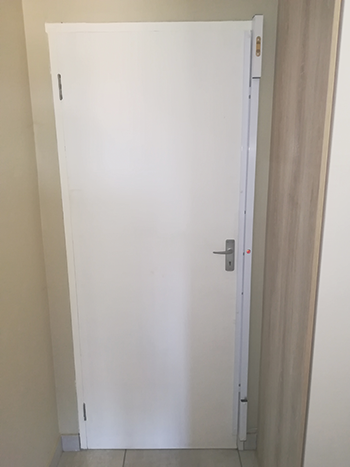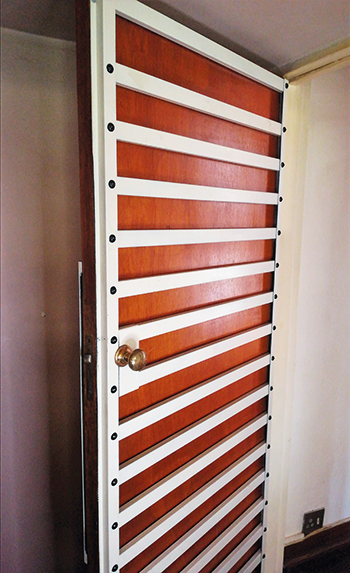
Ettienne Kock is a mechanical engineer who has designed a new type of lock, along with a ‘Smart Gate’ that is both durable and secure. Unlike the locks we are used to today, Kock’s Blade Lock has not only proven its durability in tough conditions, it is also as close to unbreakable as one can get.
Kock started his career with Armscor when it was still an excellent place to learn about designing and manufacturing top-class products. He then went on to join a clutch manufacturer, where he designed clutches and oversaw the local manufacturing process for his products. He was soon promoted to a managerial position, where he was responsible for four factories manufacturing parts for many well-known companies and projects.
He soon realised that management was not his forte, as his heart was always focused on designing new or updated products that would be better and make a difference. As an example, back in the day when families would do their monthly grocery shopping in one outing, supermarkets had big trolleys to hold all the goods purchased. Kock designed a new trolley with a floating base that would descend as more things were selected from the shelves, and then rise again as goods were taken out of the trolley and placed on the cashier’s counter.
This was a great help for people with bad backs or who were too short to comfortably take goods out of the bottom of the trolley. Unfortunately, the market changed and people are more inclined to buy less, more often, these days. The result was that his user-friendly trolley was shelved.


What’s the point of a lock?
While the unrestricted criminal efforts in South Africa are world-renowned, Kock also noticed that many crimes were committed because people could simply kick in a door, or it was simple and quick work to break and disable security doors, no matter who the manufacturer was. This got him thinking.
He says that today we have locks that can talk to you, unlock by analysing your face or even be controlled by mobile devices from far away, but criminals can still break them and enter a home or business premises with little difficulty. This led him to undertake an analysis of why this happens, which consisted of a long study of locking mechanisms used today, as well as how they are installed.
Kock explains that locks today are designed into doors and give the criminal a single point to focus on. If they can damage the door or wall around the point where the lock sits when locked, often accomplished with a few kicks, the door is open. Similarly, security doors and gates may have more than one lock, but it is only a small point load that has to be overcome to make the entire door or gate useless. A crowbar and some energy is often all that is required to make that single point load ineffective.
Even doors with a solid beam around them (and a lock in the middle of the door with a millimetre or two of space) can be broken by focusing the energy of the criminal on one point. Another facet of the design of doors is that one side of the door is supported by a beam or doorframe that won’t allow one to push the door open in that direction. Naturally this protection can’t be on both sides because that will not allow you to open the door at all – another weakness, although a necessary one with the current designs.
Remove the point load
The first step in creating a secure door and lock was therefore to take away the point load. More than that, however, any keyholes and other areas that could be picked or broken – or provide any form of leverage – had to go as well.
The result was the Blade Lock. This lock is anchored in the wall itself, not the door. The door has no keyholes or any access mechanism that forms a point load, but two steel plates on the front and back of the door (see images). The Blade Lock slots in between those plates, meaning the point load is distributed over the length of the lock – which is normally about 1,6 metres long.
Using the formula to calculate pressure (pressure = force divided by area, or p=F/A), it’s easy to see how increasing the area of the lock itself dramatically increases the pressure needed to do some damage. There is also a secret (which is patented) that Kock designed to ensure that any pressure applied to this lock is distributed over the full length of the lock.
International standards say a secure lock should be able to withstand an impact of 200 joules, which is similar to dropping 20 kg from about 1 m, or 1,5 tonnes resting on an area. Testing showed the Blade Lock easily passed this test and showed no damage. Kock admits he 'overdesigned' the lock, but his purpose was to find a solution that was truly secure.
As for durability, the first locks made were installed in a security company’s operations room, which has 24-hour access. After four years (Covid got in the way and stopped production), Kock removed a lock and examined it. The lock was functioning as it had at the start and there was no visible wear.
Reliable automation
The lock can be made for any requirement, but the thinnest plate is 5 mm thick and includes sealed bearings of 13 mm. Additionally, there is no key, so everything is automated – which obviously raises the question of reliability, given Eskom’s apparent lack of engineering skills.
The fact that the lock is electronic should be of no concern, however. Kock says the actuator he uses has been tested for 150 000 cycles. Applied to a door which is opened and closed ten times per day, this means it would last well over 20 years.
The electronic circuit that opens and closes the door was initially designed by Kock himself, but he then worked with a company to design what he calls “a formal circuit” with additional functionality. An electrical pulse of 0,3 seconds is all that is required to lock or unlock the Blade Lock. Two signals are actually sent: one to the actuator, and one to a switch at the top of the door and lock that indicates that the door is closed.
The electronic signals use approximately 8 milliamps, which means a 7 Ah, 12 V battery will last for three or four weeks before needing a recharge.
The locking circuit is also network-enabled (GSM, Wi-Fi, etc.). This means doors can be linked to a control room and warn of unauthorised access after-hours, and even for remote ingress or egress control. Kock stresses that all is needed is a positive or negative signal to lock or unlock the device.
A remote control using a roaming frequency can be used for locking and unlocking, which means that multiple people can be issued a remote, and lost or stolen devices can be locked out. Moreover, as a safety precaution for secure areas that may need lockdown solutions, a signal from a control room can lock all the doors and prevent any remotes from working until the situation is resolved.
A safe room, as another example, can also use the Blade Lock to automatically lock when the door is closed, making it safer in an emergency. Kock has also constructed a smart security gate, named the Smart Gate, where the crossbars are laser-cut into place making use of the Blade Lock. There are no welding or other weak points to attack, ensuring that a secure lock is not made useless by a weak gate.
A short video of the Blade Lock and the Smart Gate can be found at https://youtu.be/xHyg0sJ_zdg (or use the short link: www.securitysa.com/*blade).

© Technews Publishing (Pty) Ltd. | All Rights Reserved.